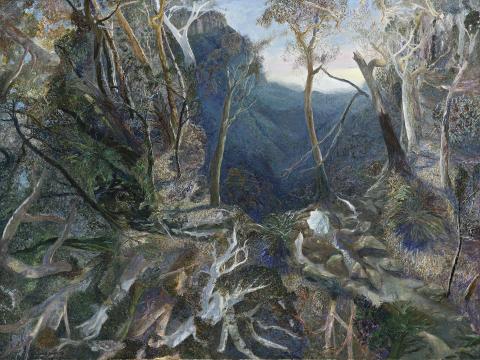MORNING TALLANBANNA, 1998
WILLIAM ROBINSON
oil on linen
137.0 x 183.0 cm
inscribed with title verso: MORNING TALLANBANNA
Acquired from the artist in December 1998
The Collection of Colin and Elizabeth Laverty, Sydney
Klepac, L., William Robinson: Paintings 1987 – 2000, The Beagle Press, Sydney, 2001, pp. 132 – 133 (illus.)
Fink, H., ‘Light Years: William Robinson and the creation story’, William Robinson: The Transfigured Landscape, Queensland University of Technology, Brisbane and Piper Press, Sydney, 2011, p. 128
William Robinson, now in his eightieth year, is widely regarded as one of Australia’s most innovative and important artists. By the time Robinson came to paint Morning Tallanbanna, 1998 his place in the canon of Australian art was already assured. As the years passed, with each new Robinson exhibition viewers have marvelled at the artist’s rolling innovations. The compositional distortions he developed down on the farm were being applied to a much grander theme – the south Queensland rainforests. The spectacular results arrived like a cool, spring breeze that blew fresh mountain air into the dusty genre of Australian landscape painting.
Robinson’s process involves long periods of observation. While wandering through his subject, he takes in the subtle shifts in light and topography, as he seeks out possible structural devices such as an ancient tree, a creek, or a more ephemeral moment like a spider web. Taking his sketches, notes and felt observations, he returns to the studio where he sets about laying the entire experience onto canvas. Speaking specifically about Morning Tallanbanna Robinson talks us through his process...
‘Tallanbanna has both rainforest and eucalypt forest. The spring-fed creeks fall at Twin Falls and neighbouring falls. This work came after many visits where I walked and observed; and at other times I made studies of trees and the undergrowth. All my paintings are painted under a great deal of light, including daylight. They are best seen in an equivalent amount of light. I make a great deal of use of coloured greys, which can react subtly with other surrounding colours. I find that the greys mixed from colour can produce a reduction which allows other colours to interact in tone and chrome. In this work, I was continually searching for completeness in composition. Sometimes I will make a window with my hands and move across the complete painting. I was particularly concerned with the placement of trees – particularly those against the space of the sky and valleys. Memory is always very important to me. The actual place itself and nature are the triggering devices. The work is completed in the memory. I find that if memory lacks absolute accuracy, it allows something else to occur in a painting, perhaps something fresh and unpredictable. I feel best when I am painting with a concern for the surface and life of the work. I like working across the surface and making links. I find that it is necessary to have persistence and regular hours of working with little variation from day to day. Walking and observing is done both morning and evening. This is not just for the looking, but for thinking about a painting; not its final image, but rather its feel even in the unfinished state.’1
The site known as Tallanbanna, within the Springbrook National Park, is well known to Robinson. He has chosen the area as the subject for several major paintings including, Springbrook with Lifting Fog, 1999, and Twin Falls and Gorge, 2000 both held in the collection of the National Gallery of Australia. The significance of the area, as the place where the eucalypt forest meets the ancient rainforest, is very important to the artist. The hoop pines which form much of the rainforest are living relics of the Jurassic Age and are amongst the most primitive conifers. Threading their way through the forests are the creeks and rivulets; the sleeping giants, which over millennia have formed the canyons, cliffs and waterfalls bringing scale and grandeur to Robinson’s majestic Landscape paintings.
1. The artist cited in Klepac, L., William Robinson, Beagle Press, Sydney, 2001, p. 132
HENRY MULHOLLAND
